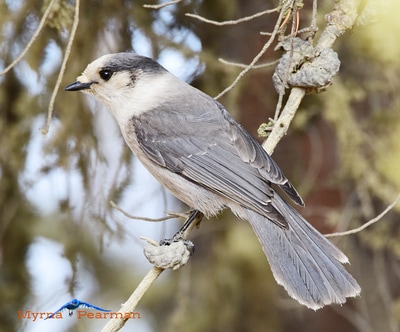 In Praise of the Canada/Gray Jay My December 2016 Red Deer Advocate nature photo essay is about a bird that has received a lot of recent publicity—the Gray Jay. As was widely publicized, the Royal Canadian Geographic Society (RCGS)—after a two-year, Canada-wide search—has chosen the Gray Jay as our national bird. In a contest that included animated debates and online voting, the Gray Jay was chosen over Black-capped Chickadee, Common Loon, Canada Goose and Snowy Owl. Although the federal government hasn’t committed to naming a national bird, the RCGS has made the case that Canada’s 150th anniversary is an appropriate occasion for our country to finally choose one. Although the Gray Jay is a quintessentially Canadian bird species, some people have complained that it doesn’t really represent Canada because it is found only across the northern boreal forests. And there was some consternation voiced over the fact that RCGS chose the Gray Jay even though the loon had won the popular vote. The core range of the Gray Jay does not extend as far east as Red Deer, but anyone who has visited the west country will be well familiar with this friendly rogue-of-the-woods. I have spent many a delightful hour watching these interesting birds. What isn’t there to love about a bird that will take treats from your hand (or leftover food from a frying pan, as shown in the images here)? Like all members of the Corvide family (magpies, ravens, crows and jays), Gray Jays are intelligent and armed with formidable memories. They thrive in harsh northern climates thanks to several unique behaviours and adaptations. For reasons that aren’t clearly understood, these birds begin nesting in late winter, often sitting on eggs by late February! Both adults (which bond for life) construct their complex nests, which are fashioned from spruce and tamarack twigs held together by caterpillar cocoons, then topped with a donut of twigs that is filled with finer twigs, bark strips and lichens and then lined with feathers and fur. Interestingly, one young from the previous year may return to help feeds its siblings the next season. Some of the unique adaptations which enable these birds to endure cold temperatures include: extra fluffy plumage; feather-covered nostrils; roosting in sheltered locations; “sun-bathing” even during cold temperatures on the wind-protected, sunny side of a tree; storing food year-round by encapsulating and then gluing morsels into hiding spots in vegetation using saliva from their enlarged salivary glands (and then remembering where they hid them!). Most people who have camped, hiked or skied in the mountains or foothills have experienced the delight of being accosted, or having their campsite food pilfered, by one of these fearless beggars. Where they occur, Gray Jays will also come to backyard bird feeding stations to dine on kitchen scraps, suet, bread and shelled sunflower seeds, some of which will be cached away for later dining. They will also eat raisins and dry or canned dog and cat food. In addition to being nicknamed Camp Robber, Meat Hawk and Moose Bird, this species has also been called Canada Jay (till the American Ornithologists’ Union lumped it with the Oregon Jay and renamed them both Gray Jay in 1957) and Whiskey Jack (from the Cree name wisedadjak, meaning mischievous prankster). There has been a growing call for yet another name change, this time to reverts its name back to Canada Jay. I fully support this suggestion—an iconic Canadian name for an iconic Canadian bird! Your comment will be posted after it is approved.
Leave a Reply. |
AuthorMyrna Pearman Archives
August 2022
|
All photos and published works on this website are copyright Myrna Pearman unless otherwise noted.
Re-posting these images or publishing is not permitted without Myrna's written consent.
Copyright Myrna Pearman Publishing 2024- Site design and maintenance by Carolyn Sandstrom
Re-posting these images or publishing is not permitted without Myrna's written consent.
Copyright Myrna Pearman Publishing 2024- Site design and maintenance by Carolyn Sandstrom






 RSS Feed
RSS Feed



14/12/2016
0 Comments